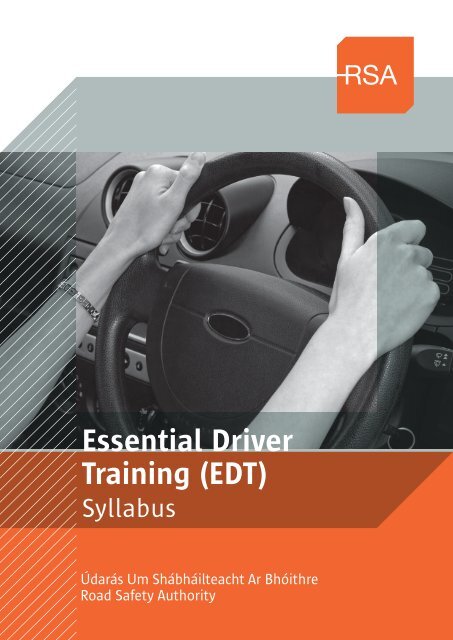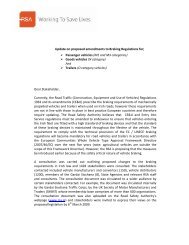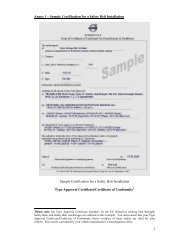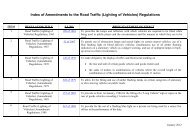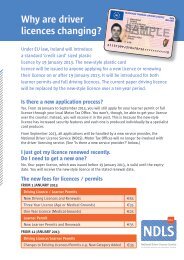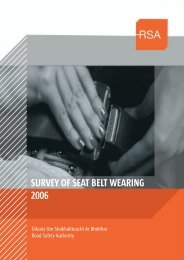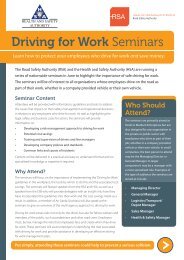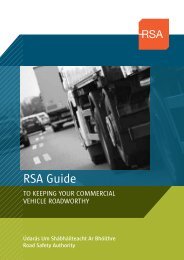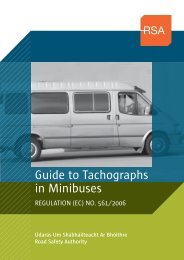Essential Driver Training (EDT) Syllabus - RSA.ie
Essential Driver Training (EDT) Syllabus - RSA.ie
Essential Driver Training (EDT) Syllabus - RSA.ie
- No tags were found...
You also want an ePaper? Increase the reach of your titles
YUMPU automatically turns print PDFs into web optimized ePapers that Google loves.
<strong>Essential</strong> <strong>Driver</strong> <strong>Training</strong> (<strong>EDT</strong>)<strong>Syllabus</strong>The 12 lessons in the <strong>Essential</strong> <strong>Driver</strong> <strong>Training</strong> (<strong>EDT</strong>) programme are designed to:• help you prepare for the practical driving test;• cover some of the most important skills and behaviours (driving habits) that a learner driver must have;• guide your progress; and• highlight the contribution the Approved Driving Instructor (ADI) and Sponsor (person who accompan<strong>ie</strong>syou while you’re practising) make to this process.We have also developed a separate Learner <strong>Driver</strong> <strong>Training</strong> (LDT) syllabus. It sets out the ‘best practice’ thatyou and your ADI should follow so that you can develop the full range of knowledge, skills and behaviours thata safe and responsible driver needs. While you are learning to drive you should cover all of these skills overtime. In addition, the <strong>EDT</strong> programme focuses on the particularly crucial driving skills.<strong>Essential</strong> <strong>Driver</strong> <strong>Training</strong> syllabusThe <strong>EDT</strong> programme does not cover all of the LDT syllabus. Instead, it focuses on the driving behaviours thatresearch shows contribute most to collision and injur<strong>ie</strong>s. The <strong>EDT</strong> works with the driver to improve theirknowledge, understanding and behaviour. It is designed to avoid high risk of harm to learner drivers and otherroad users by checking and, if necessary, correcting the driver’s:• habits;• attitudes; and• skills.Each lesson should be covered in one hour. Your ADI should choose a route for your lesson that gives you themost opportunity to have relevant practice and demonstration. At the end of each lesson you should haveach<strong>ie</strong>ved certain ‘outcomes’. These are statements that will either be:• accurate descriptions of your competence at the end of a lesson; or• can be used by your ADI as reference points for advice to you or your Sponsor about the areas of yourdriving where you need more practice and what you should focus on.<strong>Essential</strong> <strong>Driver</strong> <strong>Training</strong> syllabusDo Lessons 1 – 8 in orderYou must take <strong>EDT</strong> Lessons 1 – 8 in that order. By then, you will have built up skills and exper<strong>ie</strong>nce soLessons 9 – 12 can be taken in any order.Leave two weeks between lessonsYou should leave at least two weeks between lessons to allow for practice and learning. This mayinvolve further lessons with an ADI, but must also include practice sessions with a Sponsor or amixture of both.
Reference materialsThe Road Safety Authority publishes reference materials such as the Rules of the Road and the CarLearner Manual, which you may find useful.Spread lessons over six monthsIf you combine practice, study and instruction you will have the best chance of meeting the expectedoutcomes of the <strong>EDT</strong> programme. This is why we recommend that you should take at least six monthsto complete the 12 <strong>EDT</strong> lessons.LESSON 1: CAR CONTROLS AND SAFETY CHECKSLDT <strong>Syllabus</strong>Ref(s)How should I prepare for Lesson 1?To get the most out of this lesson and ach<strong>ie</strong>ve the expected outcomes fromthis lesson, you should have familiarised yourself with:• the Rules of the Road;• the vehicle you will be taking the lessons in and its controls; and• the information on preparing for safety checks.You should also have practised with your ADI, Sponsor, or both:• to use the vehicle’s primary controls such as steering wheel and brakes;• to use the secondary controls such as windscreen wipers and lights;• driving in qu<strong>ie</strong>t and safe conditions;• some basic manoeuvres such as starting and stopping.You should practise for at least three hours before your first <strong>EDT</strong> lesson.1.31.71.91.101.112.12.22.32.4What is the objective for Lesson 1?During your first lesson your ADI should make sure that:• you can carry out appropriate pre-start vehicle checks, includingchecking the roadworthiness of the vehicle; and• you understand the vehicle’s primary and secondary controls and knowhow to use them correctly.What is the minimum this first lesson should cover?At the very least, this first lesson must cover:• the use of primary and secondary controls;• vehicle safety; and• vehicle roadworthiness.
Expected outcomes: what should I have learnedat the end of Lesson 1?Primary and secondary controlsAt the end of the first lesson, you should be familiar with the pre-start vehiclecheck and know the location and function of the following, and be able toshow you know how to use them:• footbrake• handbrake or parking brake• steering• gears• accelerator and clutch (where fitted)• windscreen wipers and washers• lights and reflectors• horn• front and rear demisters• windows, doors and locks.You should also be able to explain why their correct and appropriate use isimportant to your own safety and that of other road users.Vehicle safetyYou should be able to explain:• what routine safety checks should be performed on a vehicle anddemonstrate how to do these;• the main reasons why a vehicle may not be roadworthy;• the safety and legal consequences of driving a vehicle that is notroadworthy; and• the main points to take into account when carrying out safety checks;You should also be able to explain:• the positive environmental impact of proper use of primary andsecondary controls;• how to plan a journey; and• where relevant, journey information may be available.How should I prepare for Lesson 2?To ach<strong>ie</strong>ve the expected outcomes from Lesson 2 you should have:• completed Lesson 1.Practice is keyTo feel confident about meeting the learning objectives, you should have:• read the expected outcomes of this lesson;• done enough practice with your ADI, Sponsor, or both; and• done any relevant study.
Specifically, you should practice using the primary and secondary controls, aswell as carrying out routine safety checks.You should also have read the sections of the Rules of the Road that deal with:• correct positioningYou should have acted on any feedback your ADI gave you at the end of yourlast <strong>EDT</strong> lesson.LESSON 2: CORRECT POSITIONINGLDT <strong>Syllabus</strong>Ref(s)What is the objective for Lesson 2?During your second lesson, your ADI should make sure that you can positionthe car correctly on the road for the actions you are about to take. Actionsinclude:• driving on the straight;• cornering;• negotiating bends and junctions;• changing lanes;• entering and exiting from slip roads;• entering and exiting junctions and roundabouts; and• correct positioning within traffic lanes.2.63.43.54.6What is the minimum this lesson should cover?At the very least, during this lesson your ADI should take you driving in lighttraffic situations so that you have enough opportunity for positioning yourvehicle:• on the straight;• in traffic lanes;• on bends turning left and right;• negotiating roundabouts; and• approaching and emerging from junctions.Expected outcomes: what should I have learned by the endof the Lesson 2?At the end of the second lesson, you should be able to show that you knowhow to:• generally keep a safe position on the road;• always keep a safe braking distance from other vehicles; and• show appropriate and safe use of available road space.
How should I prepare for Lesson 3?To ach<strong>ie</strong>ve the expected outcomes from Lesson 3 you should have:• completed Lesson 1 and Lesson 2.Practice is keyTo feel confident about meeting the learning objectives, you should have:• read the expected outcomes of this lesson;• done enough practice with your ADI, Sponsor, or both; and• done any relevant study.You should have practised the following for at least three hours:• positioning the vehicle on the straight;• cornering;• negotiating bends and junctions;• changing lanes;• entering and exiting from slip roads;• entering and exiting junctions and roundabouts; and• correct positioning within traffic lanes.You should also have read the sections of the Rules of the Road that deal with:• correct positioning in these situations; and• changing direction and making observations.You should have acted on any feedback your ADI gave you at the end of yourlast <strong>EDT</strong> lesson.LESSON 3: CHANGING DIRECTIONLDT <strong>Syllabus</strong>Ref(s)What is the objective for Lesson 3?During this lesson your ADI should make sure that you use key observationaltechniques in low-risk driving situations such as in qu<strong>ie</strong>t residential areas,qu<strong>ie</strong>t local and rural roads.What is the minimum this lesson should cover?During this lesson, you should drive in light traffic situations in order to coverthe MSMM (Mirror, Signal, Mirror, Manoeuvre) routine. You should also coverbasic scanning techniques when:• turning left and right;• turning at roundabouts; and• when negotiating junctions.1.62.62.73.23.3
Expected outcomes: what should I have learned by the endof Lesson 3?At the end of the third lesson, you should be able to show that you can:• use mirrors appropriately; and• carry out the MSMM routine correctly.You should also be able to show that you can do the proper ‘safety glances’when:• moving off;• turning;• at junctions; and• negotiating roundabouts.You should be able to show that you are aware of blind spots and how tocompensate for them.How should I prepare for Lesson 4?To ach<strong>ie</strong>ve the expected outcomes from Lesson 4, you should have;• completed Lesson 1 to Lesson 3.Practice is keyTo feel confident about meeting the learning objectives, you should also have:• read the expected outcomes of this lesson;• done enough practice with your ADI, Sponsor, or both; and• done any relevant study.Specifically, you should have practised the key observation techniques whenchanging direction for at least three hours.LESSON 4: PROGRESSION MANAGEMENTLDT <strong>Syllabus</strong>Ref(s)What is the objective for Lesson 4?During this lesson, your ADI should make sure that you can regulate andmaintain good control over the speed of your vehicle in lower risk drivingsituations, such as qu<strong>ie</strong>t residential areas, qu<strong>ie</strong>t local and rural roads.What is the minimum this lesson should cover?At the very least this fourth lesson must cover the following aspects of speedmanagement on public roads:• controlling speed;1.81.92.82.9
• speed limits;• stopping distances;• effects of road and weather conditons;• driving too fast.Expected outcomes: what should I have learned at the endof Lesson 4?At the end of the fourth lesson, you should be able to show:• you know how to adjust the speed of your vehicle appropriately forspeed limits and road layouts.You should also be able to explain the effects of:• road and weather conditions; and• a vehicle’s load on stopping distances at different speeds;You should be able to explain the potential effects of driving too fast andbraking too hard on:• your own safety;• the safety of passengers;• the safety of other road users; and• on the environment.How should I prepare for Lesson 5?To ach<strong>ie</strong>ve the expected outcomes from Lesson 5, you should have:• completed Lesson 1 to Lesson 4.Practice is keyTo feel confident about meeting the learning objectives, you should also have:• read the expected outcomes of this lesson;• done enough practice with your ADI, Sponsor, or both; and• done any relevant study.Specifically, you should have practised the use of correct speed in differentsituations for at least three hours.You should also have read the sections in the Rules of the Road on:• speed management; and• correct positioning.You should have acted on any feedback your ADI gave you at the end of yourlast <strong>EDT</strong> lesson.
LESSON 5: CORRECT POSITIONINGLDT <strong>Syllabus</strong>Ref(s)What is the objective for Lesson 5?During this lesson your ADI should make sure that you can correctly positionyour vehicle on the road for the action you are about to take. Actions include:• positioning on the straight• cornering• negotiating bends• negotiating junctions• changing lanes• entering and exiting from slip roads• entering and exiting junctions• roundabouts• reversing• turning• parking• stoppingYou should also be able to correctly position your vehicle while progressingthrough traffic and within traffic lanes.2.63.43.54.6What is the minimum this lesson should cover?During this lesson, you should drive in traffic in a var<strong>ie</strong>ty of road conditions sothat you have enough chances to position your vehicle:• on the straight• in traffic lanes• on bends turning left and right• turning left and right• negotiating roundabouts• approaching and emerging from junctions• reversing• performing a turnabout• parking• stopping in a confined space• stopping in traffic.Expected outcomes: what should I have learnedby the end of the Lesson 5?At the end of the fifth lesson, you should be able to show that you can:• consistently maintain a safe position on the road while keeping a safebraking distance;
• make appropriate and safe use of road sharing; and• perform manoeuvres (parking, reversing and turnabout) in challengingsituations.How should I prepare for Lesson 6?To ach<strong>ie</strong>ve the expected outcomes from Lesson 6, you should have:• completed Lesson 1 to Lesson 5;Practice is keyTo feel confident about meeting the learning objectives, you should also have:• read the expected outcomes of this lesson;• done enough practice with your ADI, Sponsor, or both; and• done any relevant study.Specifically, you should have practised the use of correct positioning indifferent situations for at least three hours.You should also have read the sections in the Rules of the Road on:• Correct positioning; and• Correct anticipation and reactions.You should have acted on any feedback your ADI gave you at the end of yourlast <strong>EDT</strong> lesson.LESSON 6: ANTICIPATION AND REACTIONLDT <strong>Syllabus</strong>Ref(s)What is the objective for Lesson 6?During this lesson your ADI should make sure that you:• know how to scan the environment for potential hazards; and• can identify and respond appropriately to potential hazards.3.34.2What is the minimum the lesson should cover?During this lesson, your ADI should take you driving in a var<strong>ie</strong>ty of roadconditions including:• junctions• streets with parked cars• streets with substantial numbers of pedestrians• roads with multiple warning signs• roads with poor visibility such as bends with tree cover or hill brows.
The lesson should cover potential hazards associated with:• road junctions• blind spots• parked vehicles• crossings• roundabouts• motorcyclists and cyclists• road works• pedestriansWhere it is not possible to cover one or more of these areas while driving, yourADI should ask you questions about them, which you should be able to answer.Expected outcomes: what should I have learnedby the end of Lesson 6?You should be able to show that you can use scanning techniques to identify andrespond to hazards. You should also be able to take into account potential hazards:• by choosing the correct speed and gear;• keeping a safe distance; and• braking correctly.You should be able to explain the potential effects of driving:• at night• in the rain• in fog• in snow.You should be able to show that you can identify hazards and respond to them ingood time.How should I prepare for Lesson 7?To ach<strong>ie</strong>ve the expected outcomes from Lesson 7, you should have:• completed Lesson 1 to Lesson 6.Practice is keyTo feel confident about meeting the learning objectives, you should also have:• read the expected outcomes of this lesson;• done enough practice with your Sponsor or ADI, or both; and• done any relevant study.Specifically, for at least three hours, you should have practised how to scanthe environment for potential hazards and respond appropriately.You should also have read the sections in the Rules of the Road that deal with:• correct reactions and anticipation; and• sharing the road.You should have acted on any feedback your ADI gave you at the end of yourlast <strong>EDT</strong> lesson.
LESSON 7: SHARING THE ROADLDT <strong>Syllabus</strong>Ref(s)What is the objective for Lesson 7?During this lesson your ADI should make sure that you can drive with due careand attention for the road and traffic conditions. This includes taking appropriateactions when you identify hazards.2.73.13.4What is the minimum the lesson should cover?During this lesson, you should drive in a var<strong>ie</strong>ty of road conditions including:• junctions; and• streets with parked cars.You should also drive on streets with substantial numbers of pedestrians so thatyou have significant interaction with them and know how and when to give wayto other road users.Your ADI should also require you to deal with emergency vehicles when necessary.Expected outcomes: what should I have learned by the endof Lesson 7?• You should be able to show that you can enter, cross and join roads safely.• You should know how to park safely on roads where there are other roadusers.• You should be able to pass stationary and slow moving vehicles, cyclistsand other road users safely and responsibly.• You should know when and how to give way to other road users includingpedestrians.• You should know how to deal with emergency vehicles.How should I prepare for Lesson 8?To ach<strong>ie</strong>ve the expected outcomes from Lesson 8, you should have:• completed Lesson 1 to Lesson 7.Practice is keyTo feel confident about meeting the learning objectives, you should also have:• read the expected outcomes of the next lesson (as agreed with yourADI); and• done enough practice with your ADI, Sponsor, or both; and• done any relevant study.Specifically, you should have practised for at least three hours, driving withdue care and attention for the road and traffic conditions. This includes takingappropriate actions when you identify hazards.
You should also have read the sections in the Rules of the Road that deal with:• sharing the road; and• driving safely through traffic.You should have acted on any feedback your ADI gave you at the end of your last<strong>EDT</strong> lesson.LESSON 8: DRIVING SAFELY THROUGH TRAFFICLDT <strong>Syllabus</strong>Ref(s)What is the objective for Lesson 8?During this lesson your ADI should make sure that you can drive with due careand attention where there is a significant volume of other traffic.What is the minimum the lesson should cover?This lesson should focus on:• defensive driving;• recognising risks to the safety of others; and• co-operating with other road users.During the lesson, you should drive in traffic in a var<strong>ie</strong>ty of busy road conditionsso that you have significant interaction with other road users.3.13.43.54.3Expected outcomes: what should I have learned bythe end of Lesson 8?At the end of the eighth lesson, you should be able to show that you can:• act appropriately and decisively while driving in traffic;• describe actual and potential risks to other road users and manage themeffectively;• demonstrate how to use defensive driving techniques, which do notcause hesitation or impede reasonable progress; and• demonstrate a good level of co-operation with other road users.How should I prepare for Lessons 9 – 12?Your next lesson could be any one of Lessons 9, 10, 11 or 12 as these can betaken in any order.To ach<strong>ie</strong>ve the expected outcomes from your next lesson, you should have:• completed Lesson 1 to Lesson 8.Before you do your next lesson, you should ask your ADI for advice on therelevant study material, practice, and/or driving lessons.
Practice is keyTo feel confident about meeting the learning objectives, you should also have:• read the expected outcomes of the next lesson (as agreed with yourADI);• done enough practice with your ADI, Sponsor, or both; and• done any relevant study.Specifically, you should have practised for at least three hours, driving with duecare and attention, in situations where there is a significant volume of othertraffic.You should also have read the sections in the Rules of the Road that deal with:• driving safely through trafficYou should have acted on any feedback your ADI gave you at the end of yourlast <strong>EDT</strong> lesson.LESSON 9: CHANGING DIRECTION(MORE COMPLEX SITUATIONS)What is the objective for Lesson 9?During this lesson your ADI should make sure that you can:• carry out observational and scanning tasks when turning left and right;• negotiate junctions; and• change direction in more complex and challenging driving situations.Some of this lesson should involve you making independent driving decisionsand, where available, you should make use of dual carriageways.LDT <strong>Syllabus</strong>Ref(s)3.34.1What is the minimum the lesson should cover?Your ADI should ask you to drive in traffic in a var<strong>ie</strong>ty of busy roadconditions. You should have significant interaction with other road userswhile making independent decisions about which route to take.Expected outcomes: what should I have learned by theend of Lesson 9?At the end of this lesson, you should be able to:• change course safely with due regard for traffic controls;• change course safely with due regard for other road users;• y<strong>ie</strong>ld to other road users and progress appropriately; and• change course safely using MSMM routine without prompt.
How should I prepare for my next lesson?To ach<strong>ie</strong>ve the expected outcomes from the next lesson, you should have:• completed Lesson 1 to Lesson 9.You should discuss your lessons with your ADI and, based on their advice, youmay also have completed some or all of Lessons 10, 11 and 12. This is becauseLessons 9 to 12 can be taken in any order.Before you do your next lesson, you should ask your ADI for advice on therelevant study material, practice, and/or driving lessons.Practice is keyTo feel confident about meeting the learning objectives, you should also have:• read the expected outcomes of the next lesson (as agreed with yourADI);• done enough practice with your ADI, Sponsor, or both; and• done any relevant study.Specifically, you should have practised the following for at least three hours:• using the key observation techniques when changing direction in morecomplex or challenging driving situations; and• independent driving decision-making.You should also have read the sections in the Rules of the Road that deal with:• changing directions and observationsYou should have acted on any feedback your ADI gave you at the end of yourlast <strong>EDT</strong> lesson.LESSON 10: SPEED MANAGEMENTLDT <strong>Syllabus</strong>Ref(s)What is the objective for Lesson 10?During this lesson your ADI should make sure that you can regulate andmaintain good control over the speed of the vehicle in more complex orchallenging driving situations.What is the minimum this lesson should cover?During the lesson your ADI should ask you to drive in fast-moving traffic orwhere speeds are highly variable. For example, they could ask you to drivewhere there are changing speed limits or variable traffic conditions. Some ofthis lesson should include independent driving.2.82.93.54.14.24.3
Expected outcomes: what should I have learned by theend of Lesson 10?You should be able, without prompting from your ADI, to show that you can:• manage and control your speed;• drive safely in fast moving traffic;• drive safely where speeds are highly variable; and• make decisions independently when in challenging situations.You should also be able to describe how to drive safely in fast-moving trafficduring different weather conditions.You should be able to explain how using the vehicle’s main controls andcomplying with speed limits affect the environment.How should I prepare for my next lesson?To ach<strong>ie</strong>ve the expected outcomes from the next lesson, you should have:• completed Lesson 1 to Lesson 8 and Lesson 10.You should discuss your lessons with your ADI and based on their advice, youmay also have completed some or all of Lessons 9, 11 and 12. This is becauseLessons 9 to 12 can be taken in any order.Before you do your next lesson, you should ask your ADI for advice on therelevant study material, practice, and/or driving lessons.Practice is keyTo feel confident about meeting the learning objectives, you should also have:• read the expected outcomes of the next lesson (as agreed with yourADI);• done enough practice with your ADI, Sponsor, or both; and• done any relevant study.Specifically, you should have practised for at least three hours, regulating andmaintaining good control over the speed of your vehicle, in more complex orchallenging driving situations.You should also have read the sections in the Rules of the Road that deal with:• speed managementYou should have acted on any feedback your ADI gave you at the end of yourlast <strong>EDT</strong> lesson.
LESSON 11: DRIVING CALMLYLDT <strong>Syllabus</strong>Ref(s)What is the objective for Lesson 11?For most of this lesson you should be driving independently and makingyour own decisions.During this lesson your ADI should make sure that you can remain in calmcontrol of your vehicle in situations where you may be:• frustrated;• exasperated; or• feel threatened.Your ADI should make sure that you understand the fundamentals of:• being fit to drive; and• safe loading of vehicles.2.104.14.24.4What is the minimum this lesson should cover?In this lesson, you should exper<strong>ie</strong>nce driving situations such as:• joining busy main roads;• entering junctions while driving independently;• simulating the stalling and re-starting of the vehicle; and• parking on a road with significant numbers of other parked cars andmoderate traffic volumes.You should also cover:• planning for a journey; and• fitness of passengers to travel.Expected outcomes: what should I have learned by the endof Lesson 11?At the end of the lesson, you should be able to:• demonstrate appropriate anticipation of and reactions to other roadusers;• drive safely and independently without hesitation or prompting;• explain how to deal with peer pressure or other distraction;• recover promptly and smoothly if the vehicle stalls; and• recover promptly and smoothly if conditions force you to stop.You should also be able to explain what might cause you to be unfit to driveincluding the effects of:• alcohol• drugs• prescribed medication• lack of sleep
• sickness• injury• heightened emotionsYou should be able to describe the consequences – for your own safety and forthe safety of passengers and other road users – of driving in an unfit condition.You should also be able to describe the legal implications of driving in an unfitcondition.You should be able to describe the possible consequences of carrying passengerswho are likely to distract you.You should be able to explain:• the effects on a vehicle of it being fully loaded;• how to load a vehicle safely and securely; and• the importance of not carrying more than the maximum number ofpassengers.How should I prepare for my next lesson?To ach<strong>ie</strong>ve the expected outcomes from your next lesson, you should have:• completed Lesson 1 to Lesson 8 and Lesson 11.You should discuss your lessons with your ADI and based on their advice, youmay also have completed some or all of lessons 9, 10 and 12. This is becauselessons 9 to 12 can be taken in any order.Before you do your next lesson, you should ask your ADI for advice on therelevant study material, practice, and/or driving lessons.Practice is keyTo feel confident about meeting the learning objectives, you should also have:• read the expected outcomes of the next lesson (as agreed with yourADI);• done enough practice with your ADI, Sponsor, or both; and• done any relevant study.Specifically, you should have practised for at least three hours drivingindependently in more complex or challenging driving situations, whileinteracting with significant numbers of other parked cars and traffic volumes.You should also have read the sections in the Rules of the Road that deal with:• planning for a journey;• fitness to drive;• fitness of passengers to travel; and• vehicle loading;You should have acted on any feedback your ADI gave you at the end of yourlast <strong>EDT</strong> lesson.
LESSON 12: NIGHT DRIVINGLDT <strong>Syllabus</strong>Ref(s)What is the objective for Lesson 12?During this lesson your ADI should make sure that you can:• use your vehicle lighting correctly; and• respond correctly to the lights of other road users.You should also be able to maintain full control of the vehicle while:• driving through traffic in the dark; or• in poor lighting conditions.2.103.14.24.44.54.6What is the minimum this lesson should cover?This lesson should take place after dark. Your ADI should ask you to drive in avar<strong>ie</strong>ty of road conditions, including urban and rural roads. You should havesignificant interaction with other road users.Expected outcomes: what should I expect by theend of Lesson 12?At the end of this lesson, you should be able to:• drive safely in the dark;• drive safely where road lighting is poor; and• describe the symptoms of poor night vision and how to deal with it.You should also be able to show you know:• how to use your vehicle’s lighting correctly; and• the appropriate response to other vehicle lighting, including emergencyvehicle lighting.In the event that I have not completed all 12 lessons, howshould I prepare for my next lesson?To ach<strong>ie</strong>ve the expected outcomes from your next lesson, you should have:• completed Lesson 1 to lesson 8 and Lesson 12.You should discuss your lessons with your ADI and based on their advice, youmay also have completed some or all of Lessons 9, 10 and 11. This is becauseLessons 9 to 12 can be taken in any order.Before you do your next lesson, you should ask your ADI for advice on therelevant study material, practice, and/or driving lessons.Practice is keyTo feel confident about meeting the learning objectives, you should also have:• read the expected outcomes of the next lesson (as agreed with yourADI);• done enough practice with your ADI, Sponsor, or both; and
• done any relevant study.Specifically, you should have practised for at least three hours:• responding correctly to the lights of other road users;• maintaining full control of the vehicle while driving through traffic inthe dark; and• maintaining full control of the vehicle while driving in poor lightingconditions.You should also have read the sections of the Rules of the Road that deal with:• night driving; and• driving in poor weather and lighting conditions.You should have acted on any feedback your ADI gave you at the end of yourlast <strong>EDT</strong> lesson.Completion of <strong>EDT</strong> programmeCongratulations! You have finished the <strong>EDT</strong> programme. You should now discuss with your ADI whatfurther instruction and practice you need.To get the best value from the programme, you should listen carefully to your ADI, consult with yourSponsor and, above all, practise, practise, practise.The <strong>EDT</strong> programme and your Sponsor will allow you to do this in a safe environment.
Designed by One House Communications March 2011


